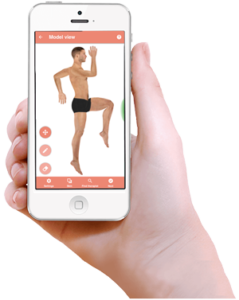Sartorius muscle, Knee pain and Postural Alignment
The Sartorius’ muscle is one of the lesser known muscles of the human body still it plays a crucial role in knee and position of the pelvis and lumbar curve.
The origin of the name Sartorius arises from the word “sartor” which means tailor in Latin. Perhaps the name arose from the position that tailors sat in the old days with the legs folded up such that the Sartorius’ muscle was kept in a state of contraction.
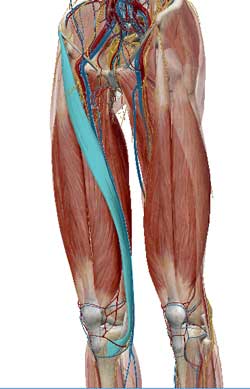
Sartorius is the longest muscle in human body even though it is quite thin and it has a significant component of fascia in it. It is divided into several compartments, unlike other skeletal muscles that can be continuous and not divided into sections.
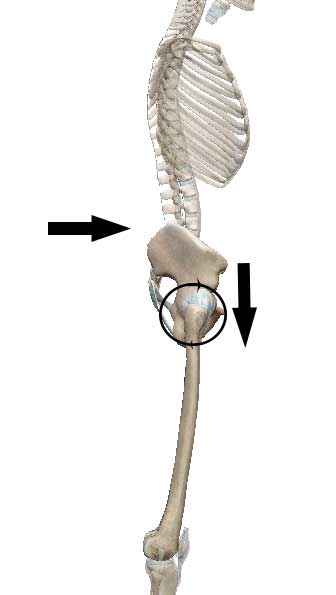
The postural implication of Sartorius.
The Sartorius is critical postural muscle and plays a crucial role in the angle of tilt of the pelvis. The Sartorius connects from the inner medial portion of the knee and loops upward to attach to the Anterior Superior Iliac Spine. Tightening in the Sartorius results in stress in the medial knee but also pulls the Pelvis forward and tilts it anteriorly. The implication of this anterior tilt is that Lumbar spine gets pulled anteriorly and pushes the abdomen forward. Of course, excessive lordosis of the lumbar spine can results in excessive kyphosis of the thoracic spine and anteriority in the neck.
The result is a lower back pain and issues in digestion, reproductive functions and excretion due to additional pressure on the intestine. It can also lead to stress on the spinal column and potential impediment of the spinal nerves arising from L4 and L5.
Downward, the tight Sartorius can pull the knees inward bring them into a knock-kneed position. You can also check the condition of Sartorius by imagining that there is a direct line from the kneecap outward. If the line points inward, then the Sartorius could be in a tightened situation.
Pain and other chronic implication resulting from a tight Sartorius
Trigger point on the Sartorius results in pain in the inner knee on the location where the muscle attaches to the Tibia. Further, Trigger Points are located along its path up to ASIS. Tight Sartorius can also result in a condition called “Meralgia Paresthetica” which is a condition with numbness in the front and outer thigh.
The most common symptom is the inability to lie on your side with your knees together as the pain the inner knee makes the position uncomfortable.
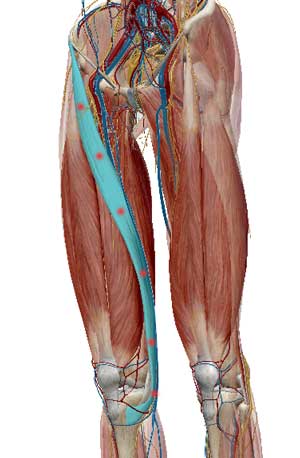
Causes of tightening in the Sartorius
If you are a yogi who sits for a long time in lotus position while meditating then, you are likely to find several fire spots on your Sartorius as this keeps the muscle on tightened position. Also a sudden extension of the hip i.e. pushing the leg back like when running without warming up can result in trauma in Sartorius. See the locations of Trps on image (marked in red).
How to release the Sartorius
Trigger Point release with self-treatment
You can sit on the floor or on a chair and palpate the muscle length to locate fire spots that generate a burning sensation. This muscle does not typically make the same kind of pain as other trigger points do, instead they create a burning sensation. You can use double thumbs to compress and release the trigger points. Check if the spots become less tender in about 1 minute and soften. Once done proceed to stretching.
Stretching the Sartorius
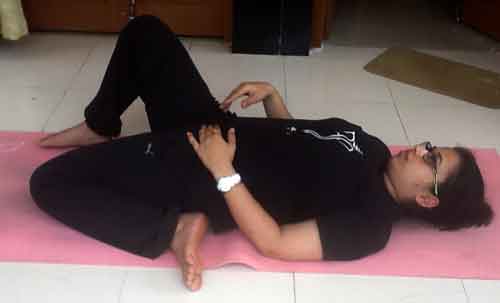
Leaning back while keeping the feet turned out works both sides together. If that is too intense, then you can work them one at a time like shown here. You should feel the stretch along the entire length of the muscle.


